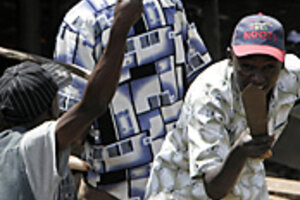Kenya's infamous Mungiki sect gears up for reprisal killings
The militia exists to defend members of the dominant Kikuyu ethnic group from further killings at the hands of rivals.

Militiamen: Members of the feared Mungiki sect are ready to avenge attacks on fellow Kikuyus.
Karel Prinsloo/AP
NAIROBI, Kenya
They gave warning to the unwelcome neighbors to leave. Then they came – dozens of young men with machetes – and hacked away at any members of the Luo tribe that they could find.
They are the Mungiki, a quasi-religious militia recruited to protect the interests of Kenya's largest and most prosperous ethnic group, the Kikuyus. Nearly finished off last summer during a government crackdown, the Mungikis have reemerged in a series of recent attacks in the Nairobi slum of Mathare that killed three and maimed more than a dozen others.
"When you see that your tribesmen are being sidelined and then slaughtered, you have to stand up and say 'No.' We fight back," says Peter, a senior Mungiki, who spoke on condition that his real name be withheld.
"Mainly our strategy is to be brutal and to send a message," he shrugs. "Sometimes it means beheading or dismembering. But the goal is to instill fear and send a message that unless they don't change what they are doing something bigger will happen to them."
Human rights activists say that militias like the Mungiki are the main reason why the postelection death toll has been so high.
Unlike spontaneous violence between neighbors, organized militias like the Mungiki sect have the capability and motivation to keep the murderous cycle of revenge attacks going for weeks.
"Initially, we were seeing three kinds of violence," says Muthoni Wanyeki, executive director of the Kenyan Human Rights Commission. Disorganized violence in villages tended to rise up suddenly, but fizzle out quickly. Organized militias – with paid, motivated members – have kept the violence going and have largely led the charge in expelling minority ethnic groups by force. Police use of extreme force – live bullets rather than water cannons or tear gas – has also stirred ethnic passions.
A fourth type of violence has now emerged, as displaced people carry back stories of horror and spur on calls of revenge in communities that had previously been peaceful. "Now we are seeing a communal response in areas where it has not happened before," says Ms. Wanyeki.
During a recent brutal attack, Peter says he led from behind, urging younger Mungiki members to attack Luos in the Mathare slum – a signal that Kikuyus are ready to use the same brutal methods that have been used against them. Three people were killed in that attack, and another 13 were maimed. Witnesses say Kenyan police watched the attack for hours before moving in to disperse the Mungikis.
"Usually the problem is between the two biggest tribes, the Luos and the Kikuyus, but this time it is all the other tribes against us," Peter says. "It's like we've been sitting on a time bomb, which is now exploding."
He looks toward displaced Kikuyu women, cooking beans and rice in massive caldrons. "Right now, the police are holding us back," he says. "But if we say now or never, there will be a civil war. Either they kill us or we kill them. I think we are going to win."
